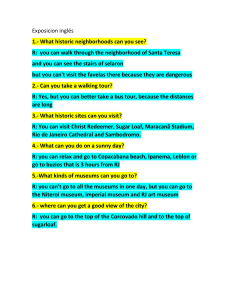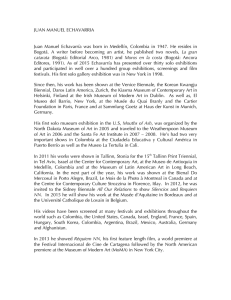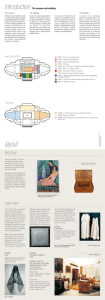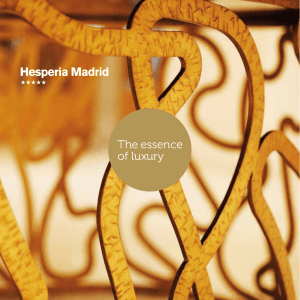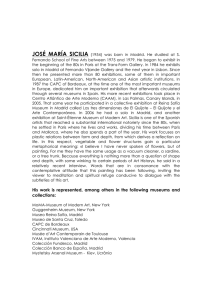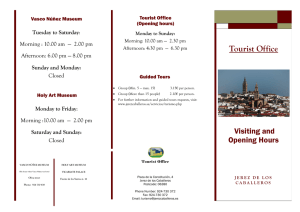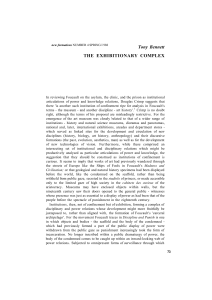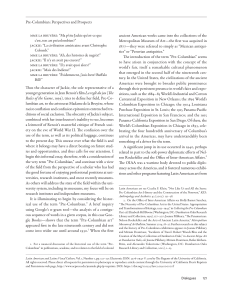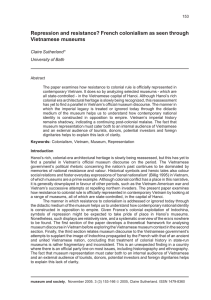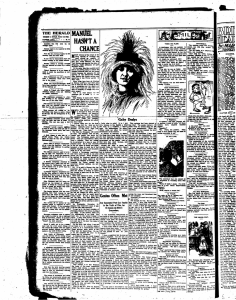it appears th¿ta lesser priority is whether people
Anuncio
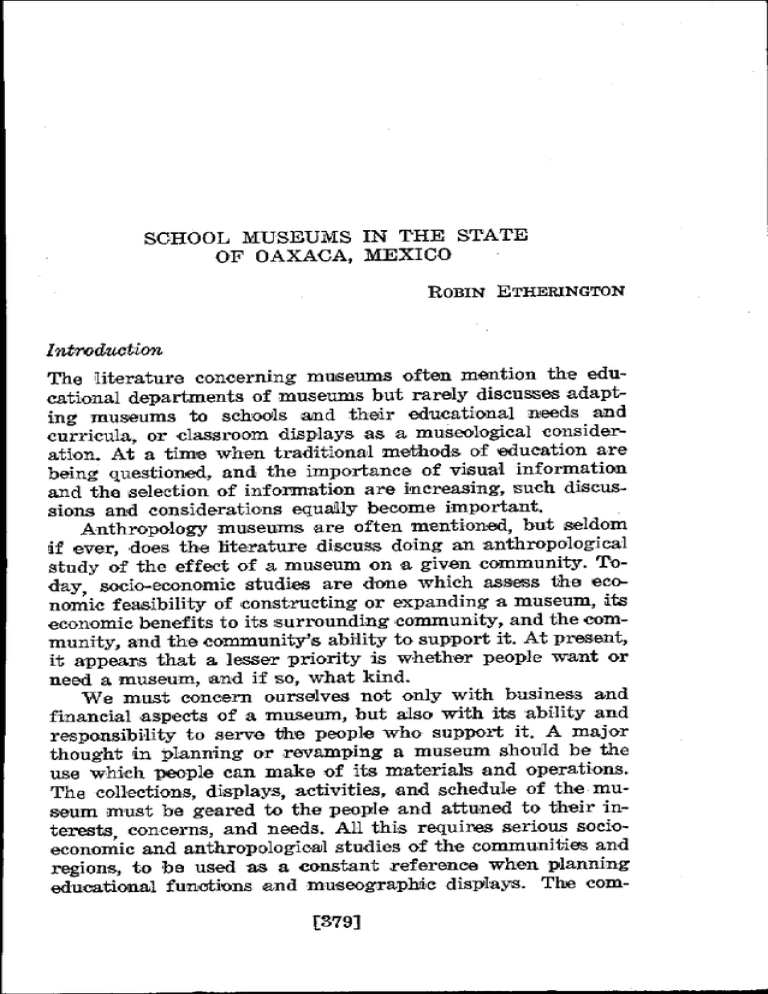
SCHOOL MUSEUMS IN THE STATE
OF OAXACA, MEXICO
RoBIN ETHERINGTON
lvLtrtúLetioll
Tho iliterature concerning muñeums often mention the educ¿tional departments of rnuseums but rarely discusses adapting museums to sehools ancl their educational ¡¡eecls a¡rd
cuiricula, or clasgroom disp ays as a milseological considen
ation. Ai a time 'when traditional methods of education ¿re
being questioned, anil the imporLanee of visual inform¿tio¡r
ancl ihe selection of information are increasing, such discussions and considsr¿tions equally beeome impor"t¿nt.
Anthropology rnuseums are often mentioned, but seldom
if ever. iloes the literature cliscuss doing: an anthropological
study of the effect of a museum on a given community' Today. socio-economic studies are dsne which assess tihe econoniic feasibility of constrrrcting or e:<panding a museum, úts
economic benefits to its surrounding community, and the communit¡ anrl the community's ability to eupport it. At pl"es'ent,
it appears th¿t a lesser priority is whether people want or
need a museum, ,and if so, what kintl.
We must concern ourselves not only with b'usiness and
financial aspects of a museum, but also with its ability and
responsibility to serve ühe people r¡¡ho support it, A major
thought in planning: or revamping a museum shouild be the
use which people can make of its materia.ls and operations,
The collections, displayq activities, and schedule of the museum must be geared to the people ¿nd attuned to their interrest,s, concerts, and needs. All this reqlircs serious socioa,nd ¿nthropological studies of the communitie and
""ottomi.
regionq to be used as a constant refere'nee when planning
eduoaüional fur¡otions and museographic displays. The comI37el
380
ANATES DE ANTBoPoI,oGL{
bination of anthropologa, education and museology provitles
a,n exciting appmach to treating such a complex concerrr, involving the socio-economic conditions in which people live.
This articlo deals with small rnuseums in the St¿te of
Oaxaca, Mexico, located in schools or dedicated to school curricuüum, in regions where the people do not have ready access to larger city museums, art galleries, theatres, üibraries,
or other cultural institutions or educational f¿cilitis. Specifically, it deals rr.ith the "Pmgra^rna de Museos Escolared',
founded by the National hstitute of Arrthropology a¡d History.
Tho Prugramme's objectives are to complement the school
curriculum, to encourage a respect for the national heritage,
¿nd to eventually establish a school museum in every school
in the country.
Mexíco's programme of school muser¡ms is unique and
deserves to be systematically examined for educators, anthropologists, and museum personnel, so that the study may
provide a model for the evaluation of the interaction of
echool<ommunity integration in developing countries,
Cons¿furafi,ons a'f Imco"ti.an
Museums
for Deuelnynent of
Sckool
The general locstion and the specific locatior¡s of ül¡e school
museums affeet their de,l'elopment and fuctioning:. It wil,l be
useful to give some idea of the conditior¡s th¿t were encountered in Oaxace during the study period, and unrler which
ühe pupils, teachers and community poop,le work anrl live,
and that affect school attendancg as well as the general educ¿tion level. The conditions that ¿ffect school attendance will
equally affect the attondance of school museums. They should
be taken into consideration during tho planning oi school
museurns and their activities, so that they arre dweloped to
encourago ronti,nual participation of all school age children,
as well as other community members,
Tbo general üocation of the school museums studieil is the
State of Oaxaca, one of the poorer States of Mexico, Aecording to the 1970 @erisus, its population rs 2,015,425. with an
annual grorrth rale of 7,6Vo for the 19?0-19?8 perio¿I, añ
compared with the national tate of 3.4Vo One reason for the
differrer¡ce in the rate, is the tendency of the p€ople (mainly
SCHOOL MUSEUM
IN TIIE STAlts OF OAXACA 381
the men) to emig:mte to the cities or to the United States
and even Canada, in search of work, v¡hich the State of O¿xaca does not have the economic means to offer them.
Another extremely important reason is the general lo¡r
level of health and the high mortality rate. A 1972 FAO
('Food and Agriculture Organization') report, noteil a nutritional inadequary for the State of Oaxaca. People in Oaxaca receive only LgVo of the normal requirements for anim¿l
protein,607o of anim¿l fats, and 507o of. vitamins A and C,
that they need. Children's growth is also seriously affected.
In the same study, it was observed that 60/o of the chiddren
and adolescents measured between the ages of five and eighL
een, had skeletal growth of less than their ch¡onological age.
"It is supposed, that the intellectual efficiency of these children will like-wise be affected by these faeto¡s of povorly."
(Varese 1979: 30).
Ths factors influencing poverty ane diversq including
poor diet, scarcity of medical attention, living conditions
which for the most pai-t do not have elernentary hygiene or
adequate sanitation, and 70Vo of the population üive i¡ dispersed or semi-dispersed communities of under 1,000 habitants, cau,si'ng communic¿tion problems.
The Programme atte¡npts to locate the individual school
museunu¡ in such small, semidispersed communities. Ilo'
wer€r, tho health and communication difficultiers of thsse
settlements often hinder their est¿blishment and development. In reality, the individual school museums have been
mainly promoted and established along highways or in towns
v¡hich have ready access to a highway and to Oaxaca City.
The promotores have not yet worked in the regions of the
State which are distant from the Central Valleys, nor for
that matter, have school museums been pi"omoted or establised in the towns and villag:es located at a distance f¡om Oa.
xaca City or that would necessitate difficu:lt travelling or
overnight stays.
Another importa,nt consideration is the school system.
Based on the 1970 census figures, 51.2/o of. the total school
ago population in the State of Oaxaca, do not receive any
school instruction. The remainine 48.8% is b¡oken-dom accortlingly: 41,5% atbend Primary school (grades L-6); 23%
attend Secondary (grades 7-9); 0'8% attend' Prepatory (gra-
#2
ANAIES DE ANIBOPOI¡GfA
10-12); and 0.6/o ¿tfend Oommunity Co,llege or UniversiB.
The greatest nurnber of pupils are at th'e P¡imary e,chool
level, at which levol there is a high peroentage of drgp-out,
due to fami'ly and work demande on the pupils, and f¿ilure
rate, because of the system of final examinations, crowded
classrooms and genelal poor school conditions.
The majority of Secondary school ago youth do not participate in tll e educalional system. Of those ¡rho attend,íI/o
go to industrial or agricultural teshnology schools. At this
'level, there is an increase in the dmFout ratp (257o), as a
rnesult of the sociaü and econonoic pressur€F on the poor families rto incorporate their young people into their zubsistenoe
d,es
economy.
We are dealing with a ¡urarl, agrioultural population in
the St¿te of Oaxaca (80% of the populatio¡r economic¿lly
acbive ¿re engaged in agriculture aocording t¿ the 1970 cen-
sus)|, whoso tr.¿ditional education con$lsts of children gradually learning from family nembers their ftrture adult rolos
and responsibilities. There arises a conflict bertween the for¡nal school soheduüe, with ite demands, and the farnily need
for the child¡en to increasingly beoome esonomic assets withún tho family complex and agricultural cycle. B'esides workimg the üa,ncls and tending the animals, rnany chiildren aocornpany their parents to the weekly m¿rket to buy and sell, or
a€com?any the,m throughout tlrc market circuit as travelling
vendotr (u'ia,ieros).
tthe people of the State of Oaxaca have a rsstricted and
limited education because of health fa,ctors 'and socic.economic conditions. These limiting factors tlictate tJut the rnajority
of the chiltlrren rnust perform an a,ctive role i¡r the subsisüeooe
of their families. Coupled with this, is the school system
itself, whieh regulates the üearning and minimizes the possibility of continued study, by rneans of the set curricu,lum,
schedule and examinations.
In short, one half of üho Oaxac¿n population do€s not
even attend, let alone fi'nish Primary sohool, thereby remaining totally or funetionally illiter¿te (4L.á% n 1974').
What is needed is ¿l alternative mode of learning for
these children (and adults). One that wil[ take into consideration their traditiorial edufation, both in content and method,
SCHOOI] MUSEUM
IN THE STAlts
OF
OAXACA
388
a¡Í weU an being oriented to their time schedule. A sohool
museum has the oppo¡trmity to offer a,n alternative to the
educationa.l systen¡ by keoping in mind the traditional education and opening its doors to the entire communit5 during
hou¡s conveni€r¡t for everyone.
Euahm,tinn of School' Museunt' 'ún Osnana
Surveyed were 47 of the 54 school rnussunrs or towns in
which tl¡e 'Programme of School M,useums' was operatfurg
in Oaxaca, at the time of the str.ldy (January to June, 1979).
B¿sed on ths observations made and t*re inforu¿tion erived
from inforrna intsl"views with pupils, teacherq community
people and the pron otores, duriurg visits to the locals, there
were 30 school museüns in an "incomplete" state, 3 school
museums were being "renovated", arid 1 school museum featured a doo¡ that was impossible to open. Therefore, we are
dea'ling with 34 rnuseums of the 54 which are officially 'listed
o¡ mentioned in meetings and reports.
This hi,gh percentag€ of non.operating: school mruieums
$uggests that the Programme in general and the Oaxacan
staff specifically, are not awale of local conditions and priorities that affeot the operability of a school muszum, or take
thern into consideration when promoting a school rnüleum
in a given locale.
In the majority of cases, the sohools' and the communitiÉs'
other neerls and priorities eliminate the possibilify of dedicated space. funds, and human resources - labour and time,
to organize and establish a school museum. Usually when
another need took prionty, or when a crisis arose, the resourc€s (not only those promised to a school museum, but
also those intended for olher oommunity projects) wers reallocated to solve th.e problem. For example, not ouly was
a school museum re,assigrred to otore beans, trut in one sehool
a p¿ú of ¿ classroom was assigned to storage use, and schools
are an accepted educational element in all communities. Only
in communities where there was a greater degree of pupil
a,nd community participation, was there an attempt to maintain the ¡esouIlces necess¿ry for the school museum to
develop and conti;nue.
384
ANALES DE ANIBOPOLOGfA
The largo number of non-operating school museums also
suggests that the Programme is imposed from above, as opposed to befurg de¡ived from and supporled by the commu-
nities themselves. That is, the Pmgramme's promotores
ar¡ilno in a¡r a¡ea to persuarle the governmental and educa"
tional authorities and the individual schools ¿nd communities, ¡Mhat a useful educ¿tional tool a school museum is,
without inquiring what the schools and communities peroeive as being impoitant for the ehildren's and the aduüts'
educatimal advancement.
There appears to be a rel¿tionship between communityschool participation (organizational level
contribution of
- echool museum,
labou,r, time, a,nd material, and use) in the
and tfre suocessful. functioning of ,a school museum in the
ischool and conmunity. In tlre main, the number of pupils
entering their school museum, either on their own or being
taken inside for a class, was low. A so in the majority of
cases, the level of community partieipation, bas¿d on the
number of community people \¡¡orking on the school museum
commif,tee (organization and decision making), and by the
nu¡nber of community people entering the school museum
(use), was minimal. The echooi rnuseurns that experÍe¡rced
participation
a greater degree of actir,r school
- community
figured among the functioning ones,
ie, open and use¿ble (ac-
.
cessible)'.
The school museums
that funcüion have a certain degr.ee
of support (,labou¡ and permission to operate or ¿ trial basis
as an experiment to increase the chances of advancement for
their children) from the community, and aceeptance by the
school staff (as an educational possibility to complement
their classes and to stimulate the pupils to study their lessons, encouraged by collecting, hanilling activities and visuál
disptrays)'. They demonstrate a greater witrlingness than the
norm to e>rperiment with ¿ new educational alternative and
to take on ¿n extra work load, snce the time demands on
teachers are considerable.
COMMENTS
We have to consider a schooi museum not as a unit separate from the school and fr¡rn the community, but ¡ather
as a unit greatly affected by the sohool situation (poor, rich,
Fmo 1. Machuilxóchitl
FoTo
2.
-
pupils visiti¡g their school museum aft¿r
school hou¡s.
San P¿blo lluitzo
-
parent, visiting school museum.
FoTo 3, San Agustín Yataxeni
a grade one teach€r directing her pupils through the Temporary Exhibition
mounted in their Pr:imary schóol.
Foro 4. ,\nimss Trujano
a tf,'pic¿l arrangement of
precolumbian ceranic heads -and pot sherds observed in
several of the school museums,
..8 5
É=6
S!5
.=<
E
qF q
H:
^üh
-9
.é p.
F FE
Éc-g
.?
ñéF
at)
E
r-
tE
ñb¡
¡-
¡F;
9-5
9^E
.E{É
{"¡
É ol4
SCHOOI] MUSEUM
IN,TIIE STAIE OT'OAXACA 386
sma¡I, urban, ál"aiüa,ble facilities, teachretrs and parrentc; interest aJId s,up])o,rt,..) and by the cornrnunity (its neeils,
interest, egonomic ability to suppolt. . . ),
Possibly a school muaelün is not immediately neoded in
a partioular school or communifur. Fo,r exa,rnpüe, enot]¡er class.
room or úeacher trairni,ng, schoo,I equiprnent (usually teachers
hal¡e to acquire their own chatlq pape", etc., not to speak of
larger pieoes of equipment or d,idactic materials), or some
farility woLrld bs more important. Some echools do not lhaw
w!¿shroo¡r0s, running water, mueh l,esñ storage areas, Co-op
storus (fianfus cooperofriaos), workshopE exira bool¡s iJ not
a libray. A:ll of therso things are lrery irnportant or fundarnental, and should be considered, bgfore discu,ssing türe fea.
si,bility of putting a.side furLds and spaoe to €6t¿bl,ish a scrhool
mu$eum. As for the community, the tirne, effo¡t and momies
could well be put to morre ussful pur.aose to beneCi't the
people and the community ¿t large, such es pmviding etorage
area"s, running water, sew,¿ge and irrigation systerns.
A sc.hool rnuseum is not nor should be q, mwre pla,ae, défir¡ed in physical terms of dimensio,ns, but rather it should
be an edueationaÍ phito'sophy, rnentaliúy, rnethodology, operable in schoole. ?hat is, even in sohools which can not affotd
to set aside a roo,m or to construct an eüfice especially fur
,a srohool muÉleum, the concept of a school rnuseurn could
stiü be furcor?orated into the curri,oulum and could rnodify
tl¡e w¿y in wh,ich ths pupils are taught.
A echool museum s,hould indeed compl€rnent the study
plan, by presenting to the pupils (snd úeashers) material and
pr.ojeobs v¡hich they normailly only see in rbwo-dirnensional
üessorw in their sohool üeoct bool¡s. Ho¡¡ever. it could be a
via,ble altei:rativre to the traditiona,l, conventional school systern, The pupiüs could be oncouraged to participate in theirr
community and to becom€ aport of tüe reai, colitsmporaly
world around thém. Instead of putting them in an ar'tificial
world of blackboards, chalk, desks and nolebooke, a:ld forci'ng
tlrem to be ta,lght ',at", the pupils wouüd '{earn with" their
teachers ¿r¡d feltrow oornmunity rnembers directly from ttre
natural and aocio-economic v¡orld in w,hich they actually live.
(trvan lüich, Paulo F,reirg Margarret Mead.)
-4 echool m,uneum has tJre potential to 'go beyond four
walle', in tlhe s,ense of oooupying the entiro cornmunify and
3E6
ANAL.ES DE ANTBOPOIOGÍA
oountrysidg and of being av¿ilablo to the pupi'ls and texhers
a,like. This mearis that the school mrü,€um rs the comrnunity
at 'large, üe socio-ecorrqmic environment in which t'he pupil's
üive. This woulcl avoid forcing them merely to exist in a
school atn¡osphere mhich is usually divoneed frorn their ¡eal
world.
In the work requirecl to create and to inrprove the school
museüns. we har,"e to tako into cronsidsratiotr the whole community and ths school eysÓem, in whioh 'bhey are functioning.
We rnust conside¡ ways and means, economicalüy and socially feasible, by which to improve the in'dividual school
Éarming noethodE teacher training, les€on con-teachingtent, facilities (workstrops, libraries, aud;io'visual aids...)
as weLl as the ¡rational school system in genera'I ( ernphasis
oa real/üiberal etlucation; incre¿s,e of respect for the teaching profe,ssion) . Also, we must consider ways to improve
the children's he¿lth, diet and ability to '¡emain in school,
along with t}lle commülities' sta,nd¿r¡ds of ü'iving ar¡d soei'oeconomic political situation.
We can not divoloe the sehool museum from its surroundings rantl from ühe peodle whom it is inteoded úo s¡erve. We
must include projects, themers, and activities that tor¡ch upon
the local and regional context and conditicnrs, in order to
m¿ke the xrupils morc aware of them a,nd to help püepare
them to solve the problems' In short, w€ must create an
atmosphere which will süm Lat'e the pupils' minds a¡d i'nterest, whioh will encourage the.rr to observe and to par"ticipate in the life of their communities, and to h¿ve p¡oiesüs
and activities that will help thern develop an ability to think
openly anrl creatively so that they can discover solutions
and alternativeis to the p¡oblenatic conditions - economic,
social, political, agricultural - of their comrnunities and ro'
gions. In this imp,¡oved clfunate, t'hey would be able to investigate ccoleratives, better rneans to oibtain water, or to t¡ansport goods to and f¡om market, or to enter the nationa,l
market s1's,tern. agrieulüural a;lter¡ratives in cr"ops and f¿rming techniques; ways to rid crops, animals and humans of
damagi.ng insects and dis,eeseE.
T!3[ü I
SCHOOL MUSEUMS LISTED ,dOCORDING TO DIST_RICtrJ
ÁRñÁñcE iñ-ñnscawuNc NUMBER PER DrsrR.rcr
Nmuber
1
District
Etla
Sa¡r Sebastián Etla
(19)
'¿
Sa¡l Agr¡stín Etla
4
GuadalüDe Dtla
5
6
Sa¡r,üo
Guadalupe EiilaJgo
San Ju¿n del Estado
Domi¡rgo B&rrio Bajo
Sa¡¡ Lorenzo CacaotePec
Sa¡¡to Degoll¿do
7
8
Matadarus
San Pa.blo Et¡á,
Soleda¡l Etl¿
Naza¡eno Etla
9
10
11
t2
Sa¡tiago Etla
Maedalerra Ap¿zco
Sa¡- Isidro EiLa
L4
L7
Ió
19
San And¡és Zautla
Sa¡ Pablo Huitzo
San FraD€igco Telixtlahuac¿
Centrc (14)
R€lyes
O¿xaca d€ Juár€z
Oaxa¿a de Juá¡ez
Trinidad de Viguers
Cuila;pa,n
23
21
26
26
28
Anioas Trujano
Sa¡r Artonio de üa Cal
Ba.rtolo Coyotepec
San Aglstf¡ ds las Jo¡tas
Dqr¿jí
Ce¡rt¡o
Sa¡ Ag¡¡stíú Yata¡e¡i
29
Guendul¿iÍ
30
Tlalixta.c de Cahrera
31
Doloreg
32
34
s6
38
39
40
4l
Lt
44
46
46
47
48
49
Ocrtlán (6)
Lo No¡ia
Nocbixttán (6)
Ya¡huiUr4n
Sa¡r
Jua¡
Sayultepec
El Cort\io
Nochixtlán
Tlacolula
(,1)
M¿sdalem¿ JalteDoc
Diaz Oñaz
Macuilxóchitl
Sa¡r Franeisco LahiPo,lo
Zaapltjla
a2
Tepo€colula (2)
64
de Ortiz
Santa l,ucla Ocotlán
S¿ntiago Tillo
50
53
Oa.xaca de Juáret
Sa¡r Antonio C. V.
Ocotlán de Mordos
Sa¡r Juan Chil¿teea
Sa¡ta C¿ta¡ina Minas
(21
Ejuüla (1)
Tlacolula de Matanioros
Villa
¿le Za¿chila
Trinidad de Zaachila
Teotongo
Tejupa.n
Ejutla de
Crespo
:
388
ANAI;ES DE ANTROPOI¡GfA
gUMMABY
Bei¡g d¡¿fted into a specialized prograrnrtre o¡ institutioD
recognition of and respect for culture, oI
t-he part of tho people. This ca¡ only be achieved when al\
Dar¿icin¿te in discovering Lhat culture for themselves, If inae€d o;e of t¡e intcnts;f foúnding the "Programa de Mus€os Esaolares", waB to teach people respect foa the ¡atiotal,
cultura¡ altifacts and heritage, present direction will nsver
accompüsh the aim, Such understanding a¡d respect comes
from the whole populace, not through an institutionalized
prcgramme such as "Progra.rna de Museos E8colares y Locales". A popular movement is necessar¡ry, úot a little corner
io a school, dedic¿ted to pot Ehelds ttrat everyone sees daily
in their fields or ¿1o¡g tlei¡ roads, with tfre oecassional non-
will lot leail to
desc¡ipt explanatory l¿bel. Such ¿ 'popular' ¿\ry'a¡€ness would
entail more t¡an respoct for eultu"¿l objests and ¡ational
heritagg but ¡atüer a caitic¿l awareness o{ the erternal society &nd its effects ¿nd control over the people and communities.
The P¡ograrMe doe6 no't a pea¡ to achieving its goals/
objectives. It mav t¡e advisable to make a ¡note indepth
a¡tlropological, socio-economic stutly of all the areas involved. and to a$eftain the local conditions and resources.
Then, put them into play toward a more efleclive opération
of the Progr"amme and the individual school Inuseums, as Fell
as use local matedal, customs, styles, tech¡ology. For example, build a school museum utilizing ths local a¡chitectural
style, but modifying it to t¿ke into consideration sound museographic ptinciples, Tlat is. to ma-ke available real, professional museogTaphic advice, but allo\r tho people t¡ decide
the technology a¡ld swle in the construction of their school
museüm, as well as content anil use of it,
Not only should \^'e pose the questio¡l o-t why t}e Programms is Íot achieving the stated objeatives, but whether ór not
the objectives a¡e even valid, Do they really consrder the
well-being of the comhúnities, ot t¿ke into consider.¿tion
the loca-l peoples' opinions, wishes a¡d customs? Everyo[e
'wants to continue ta pert-si¡ to his^er culture. a¡d not to
bo comDlete,ly melted iñto a cultural oneness. This mea¡Á
learning t¿ respect other traditions, and being respected in
tutlr.
SUMARIO
Este artículo intent¿ dar una p€rspectiva de los pequeños mue¡ las escuela¡ primarias y que sé basan en
el plan eacolar de estud-ios. Pa¡ticularnento nos referimos al
Estado de Oaxaaa, a aquellas regiones_donde la gente no tieüe
seos localiza.dos
fácrl acceso a otras fuentes de consrita, cqmo sol¡: rnuseos.
galerías, blbliotccas, itratituciones culturales u otro tipo de
servicios educacionales. No€ eüfocamos eepecialmente en el
Programa de Museos Escolares del INAE. quyos obietivos
son: prime¡o, complemeutar el ¡la¡r básico dé estudios- vdeBpués, fo,rÍentar el respeto poi el p¿trimonio nacjonal.
Este programa do museos escolare6 eú' México es mov
singula,r y mel€eé ser estudiado sist4riátic¿¡nente a fin dá
plopolcionar un modeto para la interacción de escuelas v
co@unidades de paíse¡ y regiones eo vlas de des$rollo-
SCIIOOI] MUSEUM
.
IN TIIE
STA15 OF
OAXACA
389
BIBLIoGRAPIIY
ANDER.SoN, Duane C.
19?B "Proj eet ETW: An Exemplary School-Museun
Progrram", pp. 141-157, @ Ctlrn"tor, Vol. XVI, No.
2, June.
ASHmN-WARNER, Sylvi¿
L963 Tea,cher, Banton Books, Toronto,
York.
BUNNTNG, Richarid
t57,4
Iondon; Nueva
L.
ou th€ Mussum's Role in Comrnuni'ty Adult Eduoation", pp. 56-63. en Cu,rwtor,
Vol. 17, No. 1, M,areh.
'L
Penspective
DE BoBHr,cYr, Sieph'ar¡ F.
.
L962 El Musao Como Centro ile Ia Corum¿dod,, Y. SeTinario Regional de la UNESCO, CUA/126, M&
xlco,
DE LA PEñA .EscoBAR,
Humberto
n.d.
Agustín y GoNzÁr,oz C}JLvr,z,
Los ,nluseos escokrres d.el INAH : Un i,ntento il,¿
innwtta Sm eilumüuu en Mérioo, Official Süudy
and Report, INAH, México.
EDUoATI0N FACILITIES IABoRAmRES
1976 "Hands-On Museums: partnerc in tlearning', Ep.
8-18, Exerpts from the R.epoÉ by Educatio¡ tr'a.
cilities I¿t¡o¡atories, en
January.
.
Museu'tn,
RounüAp, No. 61,
EÍTRAIT, Andrew, Roy E. FELDMAN and Harv€5' M.
SAPOLSKY
n.d.
Indn¡:íng ,poor ahíld,ren to tream, en, CIDOC, DOC69/
159, Má<ico.
EsTADos UNID0S I[xxIcANos
L97L
IX
Censo Ganeral d,e Fobla,aón, L97O, 28 de euero
d€ 1970, Estado d,e Oacaa., Volumen lI, Datos por
Munici,pto, ,Sec¡et¿úa de Industria y Comercio,
Dirscción General de Estadístio¿, México, D. F.
F¡sr¡n. Helem V.
1960 "C'hildrer¡ s m.useums¡ a definition and a credo",
'
pp. 183-191, en Curator, Vol.
III,
P¿ulo
'Ihnm¡.
tWA Pedagogy of the owressad, A
No. 2.
Conainum Boo\
The Seaway Press, Nueva York (1968).
390
ANAtiEs DE ANrRoPor¡GfA
gARvEY. Ernilv Dennis and Bernard ¡'nDBERc
tWú A ¡iuseum for t¡wpl'e, Arno Pr€ss, A Nuwa York
Times Co., Nueva York.
Tir .rcE. Iv¿]t
lgil
.
Whu we'nluBt abol,i'sh' schoolíw, e¡r CIDOC; Centm
IntrJrcultural de Documentación . DOC 70ln2,
México.
1973 ¿En Amári'm, I'otan, W¡w wé srT w la' Eeu'ela'? '
Edicionq Búsqueda, Buenoe Airgs.
JaMEs, C.
1968 "Ith€ Mueeurn and. the school curricu,ll'm'i pp,
8G86, en ICOM m'eeting on th,e xi'a of musemns in
edumtiun onil outrtural' aafinn, Mww'Lrcningrad,
l4-2LMay.
I¿n¡¡unr.' Iker
19?5 "Los Mus¡eos Essollares, Un rprograma de educscióut
prágtic¿". pp. 3-10, qt Boletín INAH, n. 75, M€
xico. octubre-diciembre.
MsaD, Margaret
1S70 "Our Educationa,l Emplusis in P¡imitive Ferspective", pp. 1-13, en From C\úü to Atl"ult' eüt'd'
bv J. Middlet¡m, Tecras P¡ess, Sourc€books in
AnthropologT, Uriiversity qf Texas Press, A,usün,
Irondon.
OnDóñEz GAr.cfA, Corel
1975 'Ttrre Cas¿ del Museo. Mexico City, An Erqerdment in bri,ngng the rnuseum to the people-', pp.
70-77, en Museu.m, Vol. 27, No. 2, UI{ESCO, Farls.
RauhDz, R.afadl
7576 La, eecwlo, ntra"l, mericonm, SEP-SETENTAS, M&
xico, D, F.
R"AMos GALrcrA, Yolanda
L!|'l
Prollticto Wra, ln erewiún de Ttt/¿/Álaos l,oúl¿s et,
Méoi"a, Ia DirEociódr de Musem, Instituto Naclonat de Antropologla ,e Historia, M6dro, agoeto.'
SDCTSIARIA DE EDUoACIóN PÚBI¡CA AND INSMTUIO
NAcI0ÑAL DE ANlRoPoI,oGfA
1972
Faitreml, Itnn om Arahnulogiml,, Arttiúic anÁ Histurnm:l Monu,mion.s, M€orican Govemmenü México.
SE0RETABÍA DE iIIDUcAcIóN PÚ,BLICA
L976
.
de PlaCoordina¿ión Educativa, Dirección G*'
neral de Plarlea¿ión Educativa, México.
Oopo¿a,
neación
Bbtenn
y
EalAtffifr4to. Subsecretaría
SCHOOIJ MUSEUM
IN TIIE
STAIE
OT'OAXACA
391
D¿vid
SrBPsaNs.'"Museurns
a¡ld Scho,ols", 'pp. 26-%, en Th,e Oca*
Yol. 3, No. 1, Summer.
SouzA C,oNZALM, Rosa Ma., Tlereea VlRcAs y Eéndira
1976
stonnl',
VII,LAMAR CALDm0N
1978 Pr'ogru,ma fu M¡tws Esoolmas, 9EP-INAH, Ménn, D. F,
Dea,rborn ed.
Eil,uwti,on o¡td Cdhnnl, Ptsaes, Tuoo,rd, an A¡t
SPTNDLER, GerEe
L9l4
tlLlspotoga of Eiluúáon, Ifolt, Rinehart &
Winsto,n, INC., Nueva York, Torontg l-ondon,
Sydney.
TaYIoR, Anne P.
1873 qOhild,ren and Artifacb - R€pla¿€ment for Te'xh
book Ileaminei', W. W;-29, en Cwato,t', VoI. XVI,
No. 1, Jrune.
lbJma. Hünberüo
L963 Croniao, fu la, Estu)dn RumL Meúmmn, Instituto
Fedeml de ,Ca,pacitacióo del Magisteri,o, Bibliote
ca
Pedag:ógioa
de
Perdeosisnami€oúo Pr"'sfesiona.t,
SEP 19, México.
VARESE, Stephano
LVI9
Proaaeas Edr.tm,tíüos g DbersíilaÁ Étrrxn,: Ell, Cañ
tl,el Estafu de Oom,a, Mdr¿do, UNESCO, Educa'
ciór¡ Perrnanenüe, Divioion d¡es Strustu¡€g. Cont+
nus Méthode 'et Techniques dEducatio,n. Ref. No,
506775, manuscript, Febre,r,o.
